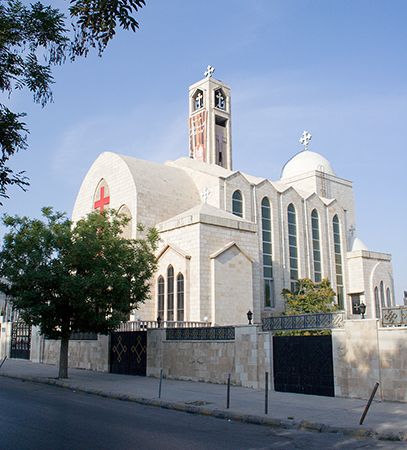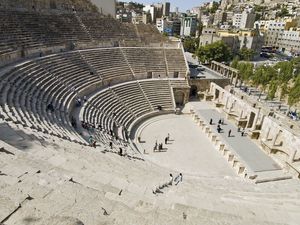Amman
News •
Amman, capital and largest city of Jordan. It is the residence of the king and the seat of government. The city is built on rolling hills at the eastern boundary of the ʿAjlūn Mountains, on the small, partly perennial Wadi ʿAmmān and its tributaries.
Amman’s focus of settlement throughout history has been the small high triangular plateau (modern Mount Al-Qalʿah) just north of the wadi. Fortified settlements have existed there since remote antiquity; the earliest remains are of the Chalcolithic Age (c. 4000–c. 3000 bce). Later the city became capital of the Ammonites, a Semitic people frequently mentioned in the Bible; the biblical and modern names both trace back to “Ammon.” The “royal city” taken by King David’s general Joab (II Samuel 12:26) was probably the acropolis atop the plateau. King David sent Uriah the Hittite to his death in battle before the walls of the city so that he might marry his wife, Bathsheba (II Samuel 11); the incident is also a part of Muslim folklore. The population of the Ammonite cities was much reduced under King David. David’s son Solomon (flourished 10th century bce) had Ammonite wives in his harem, one of whom became the mother of Rehoboam, Solomon’s successor as king of Judah.
Amman declined in later centuries. In the 3rd century bce it was conquered by Egypt’s King Ptolemy II Philadelphus (reigned 285–246 bce), and he renamed it Philadelphia after himself; the name was retained through Byzantine and Roman times. Philadelphia was a city of the Decapolis (Greek: “Ten Cities”), a Hellenistic league of the 1st century bce–2nd century ce. In 106 ce it was included in the Roman province of Arabia and rebuilt by the Romans; some fine ruins of their rule in this period have survived. With the coming of Christianity, it became a bishopric among the sees of Palestina Tertia subject to Bostra.

At the rise of Islam, Amman was taken by the Arab general Yazīd ibn Abī Sufyān in 635 ce; about 1300 it had entirely disappeared, from causes unknown to historians. In 1878 the Ottoman Turks resettled the site with Circassian refugees from Russia; it remained a small village until after World War I.
After the war Transjordan became part of the Palestine mandate, but the British government, as mandatory, effectively severed it from western Palestine (1921) and established a protected emirate of Transjordan, under the rule of Abdullah I, son of Hussein ibn Ali, then king of the Hejaz and sharif of Mecca. Amman soon became capital of this new state; its modern development began in this period and was accelerated by Jordanian independence (1946). The city grew rapidly; the urban area received a large influx of Palestinian Arab refugees after the first of the Arab-Israeli wars in 1948–49. A second, larger wave of refugees arrived after the Six-Day War of 1967, when Jordan lost all its territories west of the Jordan River to Israel. Political conflict between the Jordanian government and rebellious Palestinian guerrillas erupted into open civil war in 1970 in the streets of Amman; although the government forces finally prevailed, the city was severely damaged.
Amman is Jordan’s chief commercial, financial, and international trade centre. The royal palaces are to the east; the Parliament is in the western section. Chief industries include food and tobacco processing, cement production, and the manufacture of textiles, paper products, plastics, and aluminum utensils. Amman is Jordan’s chief transportation centre: two highways lead west toward Jerusalem, and one of the city’s main thoroughfares becomes the road to Al-Salṭ, to the northwest. Jordan’s main north-south highway, with its southern terminus at Al-ʿAqabah port, runs through the city. The modern, well-serviced Queen Alia International Airport is located near the tracks of the old Hejaz Railway, some 25 miles (40 km) south of the city. The University of Jordan (1962) and several museums and libraries, including the National Library, are located at Amman. Sites of interest include the remains of the ancient citadel, the adjoining archaeological museum, and a large, finely preserved Roman amphitheatre, which once seated 6,000. Pop. (2004 est.) 1,036,330; (2015) 3,895,991.




















